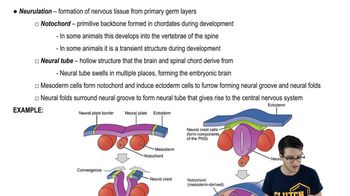Here are the essential concepts you must grasp in order to answer the question correctly.
Notochord
The notochord is a flexible, rod-shaped structure found in the embryonic stage of all chordates, including vertebrates and tunicates. It provides skeletal support and is crucial for the development of the vertebral column in vertebrates. In tunicates, the notochord is present during the larval stage, aiding in swimming and structural support.
Recommended video:
Organogenesis and Neurulation
Dorsal, Hollow Nerve Cord
The dorsal, hollow nerve cord is a key characteristic of chordates, running along the back of the organism. In vertebrates, it develops into the central nervous system, including the brain and spinal cord. Tunicates possess this feature during their larval stage, which is essential for transmitting nerve signals and coordinating movement.
Recommended video:
Chordate Characteristics
Chordates are defined by specific features such as a notochord, dorsal hollow nerve cord, pharyngeal slits, and a post-anal tail. These characteristics are present at some stage of development in all chordates, including vertebrates and tunicates, highlighting their evolutionary relationship and shared ancestry.
Recommended video:
 Verified step by step guidance
Verified step by step guidance Verified video answer for a similar problem:
Verified video answer for a similar problem:

